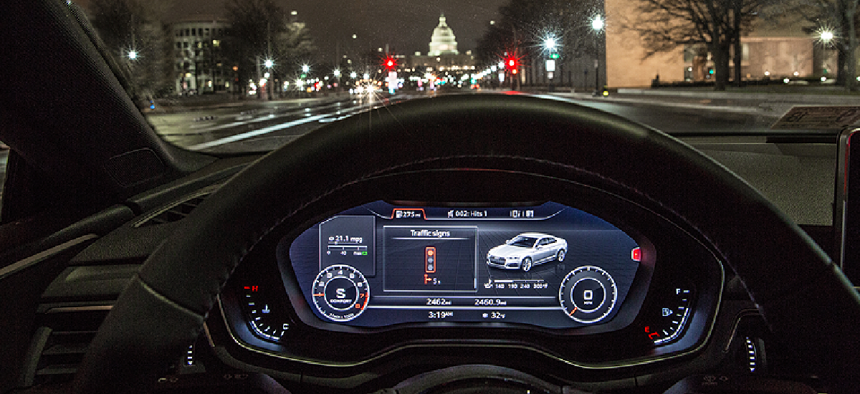Solving DC's gridlock with smarter cars, intelligent traffic signals

A data-sharing partnership has the potential to help the nation’s capital ease its notorious traffic congestion.
A data-sharing partnership between the District Department of Transportation in Washington, D.C., and automobile manufacturer Audi of America has the potential to help the nation’s capital ease its notorious traffic congestion.
“The data that we are sharing with Audi in this case is our signal system information in real time,” said Soumya Dey, associate director for transportation operations and safety at DDOT. “What we want to get from Audi in return is the information about how long their vehicles are stopping at specific intersections.”
The Traffic Light Information vehicle-to-infrastructure (V2I) system, built in partnership with Traffic Technology Services, enables select 2017 and 2018 Audi models to communicate with the city's traffic signal infrastructure. Drivers of those vehicles who have also subscribed to the Audi Connect Prime information and navigation package will be able to see on their dashboards – or heads-up displays -- how much longer they must wait for the light to turn green at about 600 intersections in the District. The company plans to implement the system at all of the District’s 1,650-plus traffic signals, Dey said.
When one of these Audi models approaches a traffic signal, it gets real-time information from the traffic management system that monitors signals via an onboard 4G LTE data connection.
“We’re providing the data to a database on a real-time basis, and they’re grabbing it as fast as we populate the database,” said Harvey Alexander, manager for traffic signal and maintenance of DDOT’s Intelligent Transportation Systems. ITS reviews, assesses, integrates and implements the latest and available technologies to enhance the district’s transportation infrastructure.
There is some latency, he said. Although DDOT updates data once per second, it takes about three seconds for the data to come from the field to DDOT’s server. “I would expect that there’s somewhere in the neighborhood of a five-second latency built into it,” Alexander said.
Wasim Raja, associate director of DDOT’s Traffic Engineering and Signals Division, can use the data about wait times at intersections to improve the district's signal timing. Right now, the district conducts a traffic signal optimization process every five years that is time-consuming and costly.
“It first collects traffic data, geographic data and geometric data to build existing traffic models, which emulates real-life traffic conditions in the field,” Raja said. “Once we build the traffic models, then we optimize those models to make multimodal improvements, not only to reduce vehicle or traffic congestion but also to make our traffic signals safer and friendlier for the pedestrians…. We improve bus-running times and also … reduce the harmful emissions from the traffic.”
But as autonomic vehicles like Audi's become more widespread, DDOT will be able to collect more data that will help keep signals optimized and synchronized more frequently. “It has a tremendous potential to reduce our overall costs for keeping our traffic signals optimized and synchronized,” Raja said.
Launched in March, the system is already providing the department with greater visibility into signal uptime and reliability in some parts of the area. Overall, though, Dey said he expects it to address three issues.
“No. 1 is it provides people information, so it’s not that the light is going to turn green faster, but at least the people know what to expect,” Dey said. “This is trying to take that frustration out of our customer base by providing information on time-to-green in the vehicle itself.”
The second benefit is to the environment. For example, if drivers see that they must wait 30 seconds for the light to change, they could turn their engines off, which results in reduced fuel consumption and emissions, he said.
Third is improved safety. Drivers might not always be able to see a signal because they’re behind a big truck or another obstruction, so this gives them another way of knowing what the signal system is doing.
But the data the city gets from Audi might be most important. “From an agency perspective, we can take the information from the vehicle manufacturer and find out how many delays we are experiencing at different intersections, and we can use that information and help us fine-tune the signal timing of specific intersections,” Dey said. “That has implications of improved traffic flow, reduced delay and all of that.”
No money exchanged hands in this deal. Instead, a memorandum of understanding was set up to make D.C. the seventh city in which Audi is testing the system. The car company started working with Las Vegas in 2016, and has also signed on Phoenix; Kansas City, Kan.; Dallas; Houston; Palo Alto and Arcadia, Calif.; Portland, Ore.; and Denver. The long-term plan, Dey said, is to make this the foundation to which other automobile manufacturers can connect as they develop similar technology.
“I think this is an example of where there are benefits obviously to the company benefits the customers and then there are tangible potential benefits to the district,” Dey said. “We are keeping our fingers crossed and hoping it takes off.”





